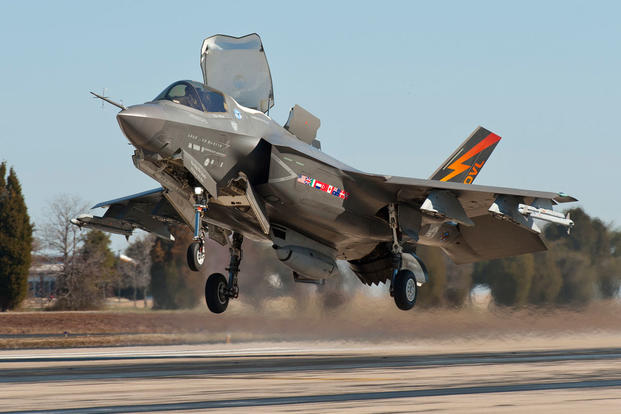The U.S. Marine Corps on Friday announced the F-35 Joint Strike Fighter is ready to fly initial operations.
After notifying lawmakers in Congress, Commandant Joseph Dunford said he "was pleased to announce" that the F-35B jump-jet version of the Lockheed Martin Corp.-made plane achieved the historic milestone, known as initial operational capability in military parlance, according to a statement released by the Corps.
The Marine Fighter Attack Squadron-121, based in Yuma, Arizona, "is the first squadron in military history to become operational with an F-35 variant" and stands "ready for worldwide deployment" with 10 of the aircraft, according to the statement.
The F-35 is the Pentagon's most expensive weapons acquisition program, estimated to cost $391 billion to purchase 2,457 aircraft for the Air Force, Marine Corps and Navy. The Corps will begin operational flights this year -- albeit with a less lethal version of the aircraft -- followed by the Air Force in 2016 and the Navy in 2019.
LONG TIME COMING
The Corps plans to buy a total of 420 of the fifth-generation stealth fighters, including 353 F-35Bs, the short-takeoff-and-vertical-landing (STOVL) versions that fly like a plane and land like a helicopter, and 67 F-35C variants designed for use aboard aircraft carriers.
Friday's announcement came nearly 14 years after Bethesda, Maryland-based Lockheed, the world's largest defense contractor, won the contract to develop the stealthy fifth-generation fighter, whose cost has nearly doubled in that time and whose development and production schedules have been repeatedly delayed.
Related Video
It came days after Lt. Gen. Jon Davis, the service's deputy commandant for aviation, said the F-35B met all the criteria for initial operational capability during a five-day operational readiness inspection. The aircraft, armed with the GPS-guided Joint Direct Attack Munition and laser-guided GBU-12 Paveway II bombs, had "impressive" exchange and kill rates in multiple mission scenarios, he said.
Configured with a version of software known as Block 2B, the aircraft can conduct such missions as "close air support, offensive and defensive counter air, air interdiction, assault support escort and armed reconnaissance as part of a Marine Air Ground Task Force, or in support of the Joint Force," Dunford said.
"The F-35B's ability to conduct operations from expeditionary airstrips or sea-based carriers provides our nation with its first 5th generation strike fighter, which will transform the way we fight and win," he added.
REPLACEMENT FOR HORNETS, HARRIERS
For the Marine Corps, the F-35 will eventually replace aging fleets of aircraft, including the AV-8B harrier, the F/A-18 Hornet and the EA-6B Prowler.
Marine Attack Squadron-211, a Harrier squadron also based in Yuma, will transition to the new fighter in fiscal 2016 and Marine Fighter Attack Squadron-122, a Hornet squadron base in Beaufort, South Carolina, will do the same in 2018, according to the statement.
During the recent operational readiness inspection, Davis said he was surprised how well the new aircraft were able to execute a high-threat scenario during an armed reconnaissance sortie. "We would never put a legacy platform -- an F/A-18 or a Harrier -- in that kind of threat environment, but these guys went and did it," he said.
So far, the Corps has trained and qualified more than 50 F-35B pilots and certified some 500 maintenance personnel to work on the aircraft, according to the statement.
LIMITATIONS REMAIN
Earlier in the week, Davis acknowledged that Marines will have to "make do" with a less lethal version of the airplane. For example, the early operational F-35Bs won't include a new night-vision helmet, Small Diameter Bomb II or GAU-22/A four-barrel 25mm Gatling gun -- or the ability to stream video or simultaneously fuse sensor data from four aircraft.
"I would have liked to have had the full four-ship fusion and the NVG full compatibility of the helmet, but I'll wait on that," he said at the time. Many of the weapons improvements will be included as part of a future software upgrade, known as 3F, which is slated for fully operational F-35Bs in late 2017.
Davis also defended the aircraft from criticisms that it can't outperform an F-16 in a dogfight or A-10 in providing close air support to ground troops. "I love the F-16, I think it's a great airplane," he said. But in a dogfight, he'd rather be in a new Joint Strike Fighter than a legacy Fighting Falcon, he added.
On Friday, Davis repeated his warning that funding for spare parts must be preserved to ensure the plane is ready to fly missions around the world. "As we field the F-35, we must remain vigilant in the forging of a sustainment system which supports readiness rates required to train for and conduct sustained combat operations," he said. "If I have any concern at this point, it is that the spare parts available to extract maximum value from this exceptional warfighting asset will be shy of what we will truly need."
The F-35 is designed to have a mission capable rate of about 74 percent, though the current figure is closer to 60–65 percent and Davis said he wants it to be upwards of 80 percent.
--Brendan McGarry can be reached at brendan.mcgarry@military.com





























